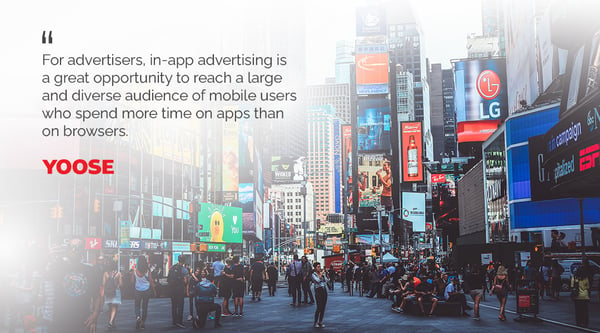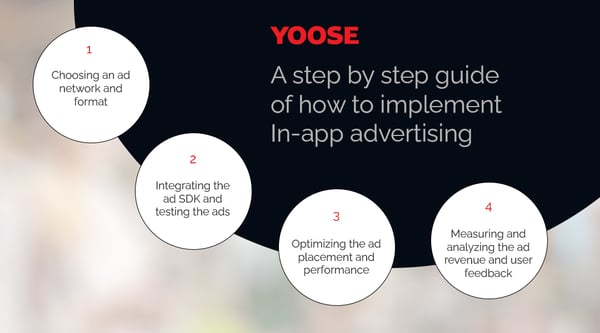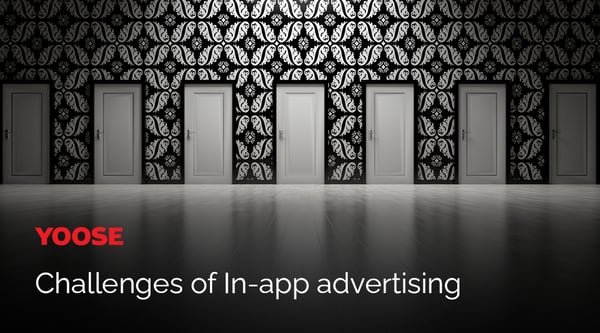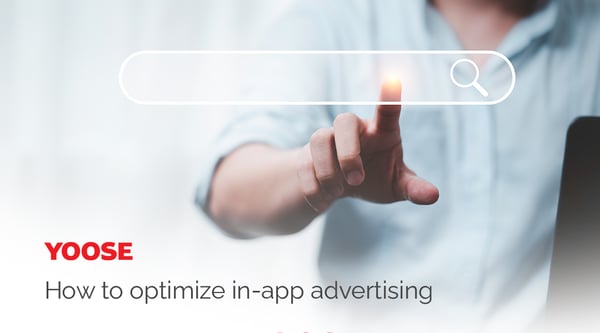In-app Advertising in Location-based Marketing
In-app advertising is a powerful way to monetize your mobile app and grow your business. In this blog post, we will explore what in-app advertising is, how it works, and what are the best practices to make it effective and engaging.
What is in-app advertising?
In-app advertising (IAA) is a way for app developers to earn money by letting advertisers show ads to users. Once developers and ad buyers reach an agreement through programmatic ad buying, these in-app ads are served through app ad networks. The ad network employs algorithms to find and deliver a high quality ad to the users in real time when an app requests an ad.

In-app ads can take various formats, such as banners, interstitials, videos, native ads, and rewarded ads. Each format has its own advantages and disadvantages, depending on the app genre, audience, and monetization goals.
Benefits of in-app advertising
For app developers, in-app advertising is a simple and effective way to generate revenue from their apps without charging users upfront or relying on in-app purchases. In-app ads can also help increase user retention, engagement, and loyalty by offering rewards or incentives for watching or interacting with ads.
For advertisers, in-app advertising is a great opportunity to reach a large and diverse audience of mobile users who spend more time on apps than on browsers. In-app ads can also deliver higher performance and conversion rates than web-based ads, as they are more relevant, personalized, and immersive.

A step by step guide of how to implement In-app advertising
In-app advertising is a popular way to monetize mobile apps and reach a large audience of potential customers. However, implementing in-app advertising can be challenging and requires careful planning and execution.

Step 1: Choosing an ad network and format
The first step of implementing in-app advertising is to choose an ad network and format that suits your app's goals, audience, and user experience. An ad network is a platform that connects advertisers with publishers (app developers) and provides the technology and services to deliver and manage the ads. An ad format is the type and appearance of the ad, such as banner, interstitial, rewarded, native, or video.
There are many factors to consider when choosing an ad network and format, such as:
- The payout model: how much and how often you get paid for displaying ads
- The fill rate: how often the ad network can provide an ad for your app's requests
- The eCPM: the effective cost per thousand impressions, which measures how much you earn per 1000 ad views
- The quality and relevance of the ads: how well the ads match your app's content and audience
- The user experience and retention: how the ads affect your app's usability, engagement, and retention
Some of the most popular ad networks for mobile apps are Google AdMob, Facebook Audience Network, Unity Ads, ironSource, AppLovin, and Vungle. You can also use mediation platforms, such as MoPub or Fyber, to integrate multiple ad networks and optimize your ad revenue.
The choice of ad format depends on your app's genre, design, and monetization strategy. For example, banner ads are simple and unobtrusive, but have low eCPM and may distract users from your app's content. Interstitial ads are full-screen ads that appear between app screens or levels, and have high eCPM but may interrupt the user flow and annoy users. Rewarded ads are opt-in ads that offer users an incentive (such as coins, lives, or premium features) in exchange for watching a video or completing a task, and have high eCPM and user satisfaction but may reduce the perceived value of your app's content. Native ads are ads that blend in with your app's look and feel, and have high eCPM and user acceptance but may require more customization and integration effort. Video ads are ads that play a short video clip, usually with sound, and have high eCPM but may consume more bandwidth and battery.
You should experiment with different ad networks and formats to find the best combination for your app. You can also use A/B testing tools, such as Firebase Remote Config or Google Optimize, to compare the performance of different ad variants.
Step 2: Integrating the ad SDK and testing the ads
The next step of implementing in-app advertising is to integrate the ad SDK (software development kit) into your app's code and test the ads. An ad SDK is a library that provides the functionality to request, load, display, and track the ads from the ad network. You can download the ad SDK from the ad network's website or use a dependency manager tool, such as CocoaPods or Gradle, to install it.
To integrate the ad SDK into your app's code, you need to follow the documentation and guidelines provided by the ad network. Typically, you need to:
- Register your app with the ad network and obtain an app ID
- Add the required permissions and dependencies to your app's manifest or project file
- Initialize the ad SDK in your app's main activity or delegate
- Create an ad unit ID for each ad format you want to use
- Add the code to request, load, display, and handle the events of each ad format
- Add test device IDs to avoid invalid clicks or impressions during testing
You should test the ads thoroughly before releasing your app to ensure that they work properly and do not cause any errors or crashes. You can use test ads provided by the ad network or real ads with test device IDs to test the ads. You should also test the ads on different devices, screen sizes, orientations, network conditions, and scenarios.
Step 3: Optimizing the ad placement and performance
The third step of implementing in-app advertising is to optimize the ad placement and performance. Ad placement refers to where and when you show the ads in your app. Ad performance refers to how well the ads generate revenue and user satisfaction.
Ad placement is crucial for maximizing your ad revenue and minimizing your user churn. You should place the ads in a way that:
- Does not interfere with your app's core functionality or content
- Does not disrupt the user flow or navigation
- Does not violate the ad network's policies or the app store's guidelines
- Matches the user's intent and context
- Encourages the user to view or interact with the ads
Some best practices for ad placement are:
- For banner ads, place them at the top or bottom of the screen, and avoid covering important UI elements or content
- For interstitial ads, show them at natural transition points, such as between app screens or levels, and avoid showing them too frequently or unexpectedly
- For rewarded ads, show them as an optional offer, such as a button or a popup, and clearly communicate the reward and the ad duration
- For native ads, place them in a relevant and organic position, such as a feed or a list, and clearly distinguish them from your app's content
- For video ads, show them in a dedicated screen or a fullscreen mode, and respect the user's audio settings and preferences
Ad performance is influenced by many factors, such as the ad network, the ad format, the ad placement, the ad quality, the user behavior, and the market conditions. You should monitor and analyze your ad performance using metrics such as:
- Impressions: how many times your ads are shown
- Clicks: how many times your ads are clicked
- CTR: click-through rate, which is the ratio of clicks to impressions
- eCPM: effective cost per thousand impressions, which is how much you earn per 1000 ad views
- Fill rate: how often the ad network can provide an ad for your app's requests
- Revenue: how much you earn from displaying ads
- ARPDAU: average revenue per daily active user, which is how much you earn per user per day
- Retention: how many users keep using your app after seeing ads
- Engagement: how long and how often users use your app after seeing ads
You can use analytics tools, such as Google Analytics or Firebase Analytics, to track and visualize your ad performance. You can also use optimization tools, such as Google AdMob Mediation or ironSource Mediation, to automatically adjust your ad settings and maximize your ad revenue.
Step 4: Measuring and analyzing the ad revenue and user feedback
The final step of implementing in-app advertising is to measure and analyze the ad revenue and user feedback. Ad revenue is the main goal of in-app advertising, but it is not the only one. You should also consider how the ads affect your app's user experience, satisfaction, and loyalty.
In order to evaluate and examine the revenue generated by advertisements, it is necessary to:
- Link your ad network account with your app store account to track your earnings and payouts
- Use revenue reports and dashboards provided by the ad network or the app store to monitor your income and expenses
- Use attribution tools, such as AppsFlyer or Adjust, to track where your users come from and how they convert
- Use cohort analysis tools, such as Firebase Predictions or Amplitude, to segment your users based on their behavior and lifetime value
- Use A/B testing tools, such as Firebase Remote Config or Google Optimize, to experiment with different monetization strategies and compare their results
To measure and analyze your user feedback, you need to:
- Use rating and review tools, such as App Store Connect or Google Play Console, to monitor your app's ratings and reviews and respond to user comments
- Use survey tools, such as Google Forms or SurveyMonkey, to collect user opinions and suggestions about your app and ads
- Use feedback tools, such as AppFollow or UserVoice, to manage user requests and complaints and provide customer support
- Use sentiment analysis tools, such as Google Cloud Natural Language or IBM Watson Tone Analyzer, to understand the emotions and attitudes of your users towards your app and ads
By measuring and analyzing your ad revenue and user feedback, you can gain valuable insights into your app's performance and user satisfaction. You can use these insights to improve your app's quality and functionality, optimize your ad strategy and revenue, and enhance your user experience and loyalty.
Challenges of In-app advertising
User experience concerns
In-app ads that are intrusive, disruptive, or irrelevant can negatively impact the user experience, resulting in frustrated and annoyed users. This can lead to negative reviews, decreased engagement, and even loss of users. To avoid this, app developers should choose ad formats that are suitable for their app genre and content, and that do not interfere with the app functionality or user flow. They should also use ad networks that provide relevant and high-quality ads that match the user's interests and preferences.

Ad blockers
Ad blockers are software programs that prevent ads from being displayed to users, reducing the chances of an in-app advertising campaign reaching its intended audience. This can frustrate advertisers and app developers who invest resources into creating and implementing ad campaigns. To overcome this challenge, app developers should use non-intrusive ad formats that are less likely to be blocked by ad blockers, such as native ads or rewarded ads. They should also communicate the value of ads to their users and encourage them to whitelist their app or disable ad blockers.
Measurement and attribution
Measuring and attributing the performance of in-app ads is essential for optimizing ad campaigns and maximizing return on investment (ROI). However, measuring and attributing in-app ads can be challenging due to factors such as multiple ad networks, different pricing models, fraud, privacy regulations, and device fragmentation. To address this challenge, app developers should use reliable and independent mobile measurement partners (MMPs) that can provide accurate and comprehensive data on key metrics such as impressions, clicks, conversions, retention, lifetime value (LTV), cost per install (CPI), cost per action (CPA), and return on ad spend (ROAS). They should also use attribution models that can assign credit to the most effective ad sources and channels.
How to optimize in-app advertising?
To make the most of in-app advertising, app developers and advertisers need to follow some best practices and optimize their strategies according to their objectives and metrics. Here are some tips to consider.

Choose the appropriate format
Different ad formats suit different app genres and user behaviors. For example, banner ads are good for utility apps that have frequent sessions and low engagement time, while rewarded video ads are ideal for gaming apps that have high engagement time and need to incentivize users to continue playing.
Segment your audience
Not all users are the same, and not all ads are equally appealing to them. By segmenting your audience based on their demographics, preferences, behavior, and other criteria, you can deliver more relevant and personalized ads that match their interests and needs in your in-app advertising campaign .
Test and measure your ad performance
To find out what works best for your app and your audience, you need to test different ad formats, placements, frequencies, creatives, and messages. You also need to measure your ad performance using key metrics such as impressions, clicks, conversions, revenue, eCPM (effective cost per mille), fill rate, retention rate, etc.
Partner with a reliable ad network. A good ad network can help you access quality demand sources, optimize your ad inventory, maximize your revenue potential, and provide you with support and guidance. Some of the leading ad networks in the market are Google AdMob, ironSource, AppsFlyer, AdPushup, etc.
The real case study of In-app advertising
One example of a successful in-app advertising campaign is the one launched by Spotify, the leading music streaming service, in 2019. Spotify wanted to increase its brand awareness and user engagement among millennials and Gen Z in the US, UK, and Australia. To achieve this goal, Spotify created an interactive and immersive in-app ad experience that allowed users to explore different playlists based on their mood, genre, or activity. The ad also featured a call-to-action button that invited users to download or open the Spotify app and listen to the playlists. The campaign ran for six weeks and reached over 50 million unique users across the three markets.
The results were impressive: Spotify saw a 21% increase in brand awareness, a 30% increase in ad recall, and a 9% increase in app installs among the target audience. The campaign also won several awards for its creativity and effectiveness, such as the MMA Smarties and the IAB MIXX Awards. Spotify's case study shows how in-app advertising can be a powerful tool to showcase a brand's value proposition, engage users with relevant and personalized content, and drive them to take action.
Conclusion
In-app advertising is a win-win situation for both app developers and advertisers who want to monetize their apps and reach their target audience effectively. At YOOSE, we know how to choose the right ad format, segmenting your audience, testing and measuring ad performance, and partnering with a reliable ad network, we can optimize your in-app advertising strategy and achieve your goals. You can learn more about in-app advertising and mobile marketing here.



